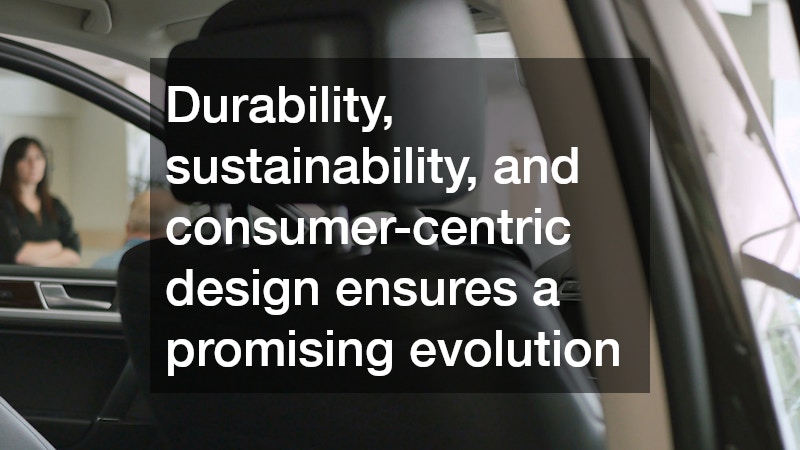As the automobile industry races towards the future, interior comfort and aesthetics are becoming more important than ever before. Automobile upholstery, in particular, is at the forefront of this revolution, driven by technological advancements, environmental awareness, and changing consumer preferences. In this article, we explore the top trends in car upholstery for 2025, focusing on the innovations and materials set to redefine the driving experience.
Eco-Friendly Materials and Sustainable Practices
One of the most significant trends in automobile upholstery for 2025 is the shift towards eco-friendly materials. Manufacturers are increasingly using sustainable fabrics to reduce their environmental footprint. Organic cotton, recycled polyester, and even pineapple leather are making their way into car interiors, offering a green alternative to traditional leather and synthetic materials.
This green trend is not just about materials but also includes sustainable production practices. Companies are committing to reducing waste and energy consumption during manufacturing processes. This holistic approach ensures that upholstery is not only environmentally conscious but also stylish and durable.
The use of eco-friendly materials aligns with the growing consumer demand for sustainable products. Car buyers are more informed and environmentally aware, seeking vehicles that reflect their values. As a result, eco-minded upholstery is becoming a key selling point for modern automobiles.
Advanced Technology Integration
As vehicles become smarter, so too does the upholstery within them. Advanced technology integration is one of the top trends, with features like built-in heating, cooling, and even massage functionalities becoming standard. The integration of smart textiles and responsive fabrics allows passengers to enjoy unprecedented comfort and convenience.
Automobile upholstery is now incorporating technology that offers health monitoring capabilities. For instance, sensors embedded in the fabric can monitor vitals such as heart rate and stress levels. This innovation not only enhances comfort but also provides an additional layer of safety for drivers and passengers.
Manufacturers are also exploring the potential of augmented reality (AR) interfaces integrated into upholstery. AR overlays can provide navigation cues or display relevant information directly on seats or headrests, creating a futuristic and interactive driving environment. As technology continues to evolve, upholstery will undoubtedly offer enhanced connectivity and functionality.
Customization and Personalization
The move towards customization and personalization is another burgeoning trend in automobile upholstery. Car buyers today desire interiors that reflect their unique tastes and lifestyles. Options for personalized stitching, color schemes, and even embroidery patterns are becoming widely available, allowing consumers to create truly bespoke interiors.
3D printing technology is also playing a crucial role in this trend, enabling the production of intricate designs and components tailored to individual specifications. This level of customization extends beyond aesthetics, as ergonomic designs and adjustable features cater to personal comfort preferences. Upholstery in 2025 will be as much about identity as it is about function.
Additionally, manufacturers are offering apps that allow customers to visualize and configure their vehicles’ interiors in real-time. By providing a virtual experience of different design options, these apps empower consumers to make informed choices about their upholstery, ensuring that every detail aligns with their desires.
Durability and Innovation in Fabrics
The demand for durable, high-performance fabrics is driving innovation in automobile upholstery. With advancements in textile technology, manufacturers are creating materials that offer superior resistance to wear and tear. These fabrics are designed to withstand varied climatic conditions, making them ideal for global markets.
Nanotechnology is being utilized to enhance the durability and functionality of automotive fabrics. Nano coatings protect upholstery from stains, moisture, and UV rays, extending the lifespan of the seats. This technological innovation ensures that upholstery retains its new look for longer, even in demanding environments.
Consumers are increasingly interested in low-maintenance options, and durable fabrics deliver on this front. Easy-to-clean surfaces answer the common concerns of spills and dirt, making them a popular choice for families and individuals with active lifestyles. As durability continues to be a priority, upholstery of 2025 will offer both style and substance.
The trends in upholstery are not just about aesthetics; they reflect a shift towards a more holistic and sustainable approach to vehicle design. As we look towards 2025, the integration of advanced technologies, eco-friendly materials, and personalization options will redefine how we interact with our vehicles. Automobile upholstery is at the cutting edge of these developments, symbolizing the harmony between innovation and tradition in the automotive industry.
These advancements in material technology and design are poised to create driving experiences that are more comfortable, personalized, and environmentally responsible. Whether through the tactile sensation of high-tech fabrics or the visual impact of a customized interior, upholstery will continue to enhance the journey, making every ride unforgettable.
The focus on durability, sustainability, and consumer-centric design ensures a promising evolution for automobile upholstery. As the industry adapts to new demands and possibilities, it will be exciting to see how upholstery trends shape the future of transportation, providing a canvas for creativity and innovation.

